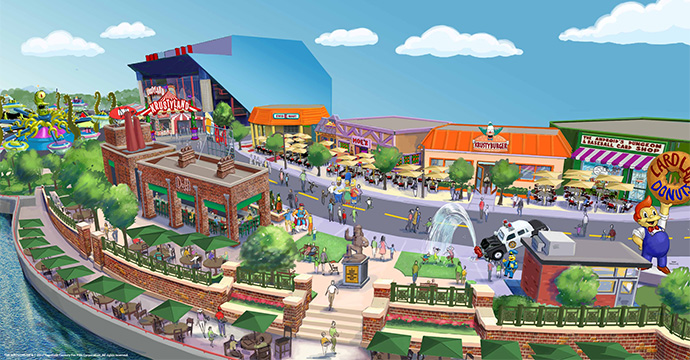
The economic impact of “The Simpsons” might be hard to quantify, but would have to include the investments made by Universal Orlando Resort in its area dedicated to the TV show, which it bills as “the only place in the world where guests can walk the streets of Springfield.” Attractions include the vertiginous Simpsons Ride (below).
Images courtesy of Universal Orlando Resort

It’s an odd byproduct of satire: Through the clarifying effects of ridicule and hyperbole, it can inspire genuine affection for both itself and the thing it lampoons.
Such is the case with “The Simpsons,” which is the longest-running scripted television show in history and this week begins its 26th season. By way of tribute, this week our “What’s In a Name?” series —which previously visited places named Independence and Columbus — examines corporate facility investment project data from places named Springfield.
In the show’s May 19, 2013, episode, “Dangers on a Train,” a sign appears: “Springfield: 20 Miles, Please Lower Your Expectations.”
If anything, the Springfields of the real world seem to earn raised expectations. And their strength resounds in the heartland terrain and values that “The Simpsons” satirizes and, therefore, holds dear.
It turns out Site Selection’s proprietary New Plant Database launched in 1989, the same year that the animated series was born. Over that span, the Springfields of the world have welcomed nearly as many corporate facility investments (516) as viewers have welcomed broadcast episodes of “The Simpsons” (552).
The projects amount to close to $4 billion in value, and have occurred in 20 cities named Springfield, out of the reported total of 50-some-odd cities, towns and townships in the US graced with the name. According to an evaluation early this year by Statistic Brain Research Institute, that’s almost equal to the value of “Simpsons” merchandise and toy sales ($4.6 billion) and about a third of the value of the overall “Simpsons” franchise ($12.33 billion).
Two Springfields — in Illinois and neighboring Missouri — not only account for 45 percent of all Springfield projects, but also both sit on the famous Route 66. And a corridor of Springfields in the row of states that includes those two towns and their sister cities in Kentucky and Ohio accounts for 78 percent of all Springfield projects we’ve tracked.
But it’s not just an American name: In 2009 we tracked a $2-million, 200-job project from Indian software services company Dhanush Infotech, as it chose Springfield, Queensland, Australia, for its Asia Pacific headquarters.
Dhanush Chairman DSN Murthy said a number of factors influenced the firm’s final decision to base its Asia Pacific operations in Springfield, a suburb of Adelaide.
“Queensland is recognized as a leader in IT security and games development, and is a significant provider of software to asset intensive industries,” Murthy said. “The positive business climate in the region, the opportunity for ongoing business partnerships here and the support from the State Government all contributed to the business case for choosing Springfield.” The company has gone on to develop its own technology academy in partnership with area universities and institutions.
That opportunity exists in the fictional Springfield too, with such esteemed institutions as Swigmore University, where Moe Szyslak matriculated before becoming a bartender. (Alas, “Moe’s University” only existed in one of Homer’s dreams.) Other schools include Springfield Community College, Springfield Heights Institute of Technology and Springfield University, where Homer was sent in 1993 after the Nuclear Regulatory Commission found him incompetent, and he ended up coaching three nerds in his own brand of life lessons.
Mmm … Projects
Which real Springfield wins the project tally? You might as well ask which Simpson family member ranks highest. A more relevant question would be, “Have any of the Springfield economies been especially driven by electrical power, beer or … perish the Homeric fantasy … both?”
Yes.
Site Selection has tracked 135 projects over the past 25 years in Springfield, Mo., the southwest Missouri home of Missouri State University, the International Association of Fairs & Expositions, Associated Electric Cooperative and the headquarters of Bass Pro Shops and Tracker Marine. (Until this summer, our proprietary New Plant Database required a minimum of $1 million invested, 50 new jobs created or 20,000 new sq. ft. of space. The job creation number for qualification now has been revised to 20.)
Among other plaudits, the city recently was ranked as the 15th best city for job growth among midsize US cities by Newgeography’s Joel Kotkin, and the 24th best city in the nation to start a business in a recent study published by small business and personal finance site WalletHub.
Building on a history of lead mining in its Ozarks region, Springfield also has welcomed its share of battery company investments and innovation, including from NorthStar Battery, which in 2008 chose Springfield over China for a $53-million, 300-job expansion after a $5.5-million, 60-job project just four years previous in its headquarters city. The global company recently opened a support center for the Middle East and Africa in Dubai. But it’s also recently supplied 80 batteries for the battery bank of a unique off-grid wind- and solar-powered home in Springfield called Bruner Ridge.
Right next door to Springfield, in Joplin, EaglePicher Technologies (bought by the OM Group in 2009) develops batteries and robotics for aerospace and defense, among other sectors from its campus downtown, where a few years ago we visited with Program Manager Darrell Ideker. At the time he also served as chairman of the board for the Missouri Center for Advanced Power — a collaboration between EaglePicher and four major universities (Missouri Southern, UM-Columbia, Missouri S&T and Missouri State in Springfield) known by the Simpson-esque acronym of MOCAP.
Which brings us to the beer.
In 2010 Mother’s Brewing Co. invested $1.9 million and created 10 jobs at a new brewery in downtown Springfield that as recently as last year was ranked the seventh-fastest growing craft brewery in the nation. Led by owner, entrepreneur, downtown champion and “Carouser-in-Chief” Jeff Schrag, the operation today employs about 20 people in a 112-year old building that began as a bottling plant, then was operated for decades as a bread bakery, beginning in 1926 with the Mueller Baking Co.
Today, Paul Mueller Co. is still going strong in Springfield, making stainless steel equipment for the food and beverage, chemicals, pharma and other sectors, and has invested multiple times in Springfield facilities over the past 10 years, creating hundreds of jobs across a manufacturing campus encompassing more than 1 million sq. ft. Another stainless steel tank manufacturer, Watson Metal Masters, last year invested $4.8 million in a 77-job expansion in the Springfield-area town of Republic, Mo., doubling the workforce.
Mother’s Brewing Co., meanwhile, is one of 2,768 craft breweries in the United States, according to the Brewers Association, representing more than a 15-percent jump in number over 2012, and nearly evenly split between microbreweries and brewpubs, with 119 large enough to be called regional craft breweries. The craft brewing industry contributed $33.9 billion to the US economy in 2012, and provided more than 360,000 jobs.
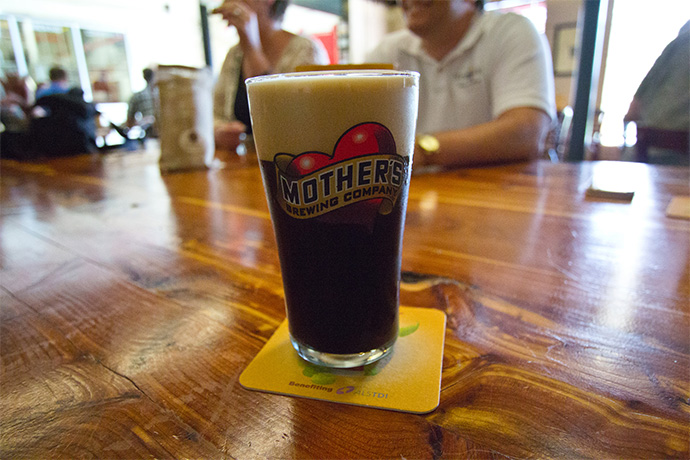
Mother's Brewing Co.'s home in Springfield, Mo., is just north of Walnut Street at the corner of Grant and old Route 66 —America's Mother Road.
Photo courtesy of Missouri Tourism
The official Brewers Association member roster includes Mother’s of course, as well as Springfield Brewing Co. and White River Brewing Co. in Springfield, Mo.; Engrained Brewing Co. and Obed & Isaac’s American Ale House / Land of Lincoln in Springfield, Ill.; Hop Valley Brewing Co. in Springfield, Ore.; Soaring Wings Brewing in Springfield, Neb.; and a “brewery in planning” in Springfield, Pa.
To that one can only say one thing: “Woo hoo!”
Values and Value
The Missouri Springfield’s total is just barely topped by the 138 projects over the past 25 years in Springfield, Ohio, found in Clark County just northeast of Dayton along I-70, and not to be confused with the state’s several Springfield Townships, which have attracted 26 projects of their own. In addition to an aerospace presence that’s part of the Greater Dayton area’s value proposition (including close to 100 new jobs coming to HDI Landing Gear), among the area’s recent corporate investments was an August announcement that Dole Food Co. would spend $9 million on packaging and processing expansions for spinach, spring mix and baby lettuce packaged vegetable products, adding 140 jobs to the current payroll of 600.
“Our Springfield facility was the best location for us to expand and add this new capacity,” said John Lochra, Dole’s plant manager. “This investment will add new capabilities to our Springfield operations allowing us to supply the northeastern portion of the United States more efficiently.”
“Dole has been a significant employer in the Greater Springfield community since 1997,” said Greater Springfield Chamber of Commerce President Mike McDorman. “The Chamber, CIC, City of Springfield, Dayton Development Coalition and JobsOhio worked closely with Dole to help meet their immediate and long-term needs. We are excited they have chosen to continue to grow their operations in Clark County.”
In July, Speedway LLC (Speedway) announced that over the next three years it plans to purchase an existing facility at the NextEdge Applied Research + Technology Park in Springfield and renovate a portion of its headquarters in nearby Enon to accommodate approximately 350 new jobs and retain approximately 800 employees. The $9.1-million expansion comes after the recent acquisition of Hess Retail Holdings, making Speedway, a subsidiary of Ohio-based Marathon Petroleum Corp., the largest company-owned-and-operated convenience store chain in the U.S. by revenue and the second largest by number of stores.
“Clark County was the best location for us to expand and add these jobs,” said Speedway President Tony Kenney. “Having facilities in Enon and now in Springfield keeps our operations close together in a central location that is good for attracting talent. The community’s affordability, quality of life, great schools and health care system make it an ideal location for our future growth and, more importantly, for our employees who will be working and living here.”
Springfield, Illinois, the state capital, has attracted 96 projects since 1989, including a recent $3-million, 50-job R&D project from biometrics firm Morpho Trust USA and — are you paying attention, Homer? — multiple expansions from Mel-O-Cream Donuts International, which has called Springfield home for 80 years.
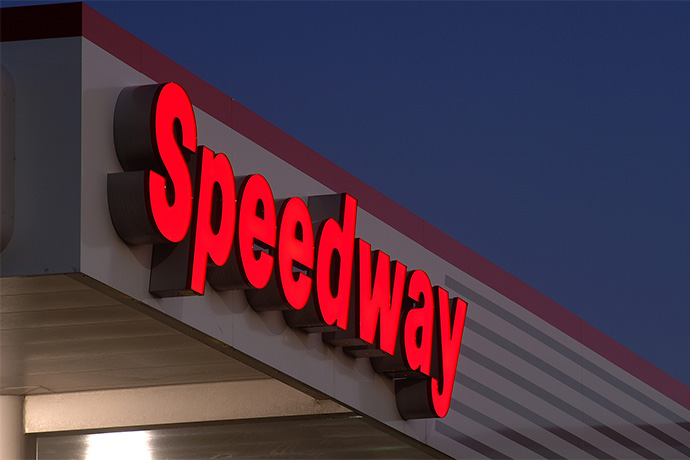
Marathon Petroleum subsidiary Speedway is investing more than $9 million and creating 350 new jobs with a headquarters expansion in Springfield, Ohio, which has seen 138 new projects enter Site Selection's New Plant Database over the past 25 years.
Photo courtesy of Marathon Petroleum Corp.
Having recently invested $15 million in a renovation of its convention center, Springfield also is seeing a bump in tourism. In 2013, Sangamon County tourism expenditures were $406.82 million dollars (a 4.8-percent rise from 2012), with 3,230 people employed in tourism-related jobs and a total payroll of $88.78 million dollars. Local tax receipts generated were $7.53 million dollars, and state tax receipts collected were $24.54 million dollars.
In early September, the Council of Council for Community and Economic Research (C2ER) released the results from its Q2 2014 Cost of Living Index. Springfield, Ill., earned a Cost of Living Index score of 87.9, signifying living expenses 12.1 percent below the average U.S. city, and the lowest cost of living in Illinois. The area’s most pronounced cost advantages appeared in housing (with an index score of 80.6 compared to a state score of 92.5) and utilities, where Springfield merited a 78.5 score vs. a score of 94.4 for Illinois as a whole.
A total of 34 projects have come to Springfield, Ky., equidistant from Lexington and Louisville in the south-central part of the state. And 31 projects have come to Springfield, Tenn., not far south of the Kentucky state line, north of Nashvile.
Kentucky’s Springfield boasts one of the most consistent corporate investors over the 25 years: Automotive supplier Toyotomi America has invested more than half a dozen times there since initially setting up shop in 1999. The supplier to Toyota and Tesla, among others, employed nearly 300 people as recently as early 2013. According to the Springfield-Washington County Economic Development Authority (SWEDA), Toyotomi expanded five times alone in 2011 to accommodate new machinery and processes, and in 2012 embarked on a 57,000-sq.-ft. addition.
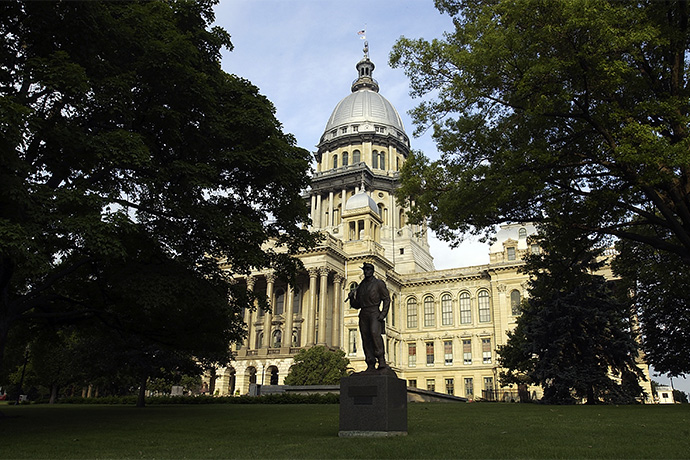
Springfield, Illinois, the state capital, has attracted 96 projects since 1989. It’s also one of the most affordable cities in the nation.
Photo courtesy of Illinois Office of Tourism
Nearly as active in the same town has been the auto supplier formerly known as Springfield Products, and today known as INOAC, which first established its operation there about the time the New Plant Database and “The Simpsons” got started 25 years ago. The company in August was approved for a $2.45-million tax incentive package for upcoming expansion. In April, Kurt Krug, the company’s vice president of North American human resources, was one of 12 people appointed to the state’s newly created Kentucky Automotive Industry Association. Kentucky’s 460 motor vehicle-related establishments employ nearly 82,000 people. In the past five years, nearly 300 motor vehicle-related projects have been announced statewide, representing more than 17,600 new jobs and $4 billion in new investment. Kentucky’s motor vehicle exports reached a record $5.5 billion last year.
Tomorrow, The World
Among the corporate-world highlights of the upcoming “Simpsons” season, C. Montgomery Burns —the nuclear power plant mogul who came in at No. 10 this year in Forbes’ annual “Fictional 15” ranking of richest fictional characters — loses all of his money to none other than Elon Musk of Tesla, SpaceX and Gigafactory fame, guest-voicing as himself.
Are there other connections between the world of “The Simpsons” and the world of economic development? Yes, Smithers, yes there are.
“Simpsons” creator Matt Groening in 2012 told Smithsonian Magazine that Springfield, Ore., part of the Eugene-Springfield metro area, was the town his fictional city was named after, and also admitted naming some of the fictional streets and characters after real people in his native Oregon, where he grew up near Portland and later jumped just north to attend Evergreen College in Washington. Site Selection hasn’t tracked very many projects in Springfield, Ore., but the few we have on file include two related to CD manufacturing and packaging from the 1990s, a $38-million investment from Franz Family Bakeries/US Bakery in 2007 and a call center from Royal Caribbean Cruise Lines that came to town in 2006.
As of 2012, as a 140-job expansion took place, the center was employing more than 600 people and hoped to reach 900. But that’s now history: Early this month, the company announced it would hire 220 to add to its 719-strong payroll. (In case you’re wondering, “The Simpsons” did take a cruise once, in Season 23, Episode 19, titled, in tribute to the wickedly funny essay about cruises by the late David Foster Wallace, “A Totally Fun Thing That Bart Will Never Do Again.”)
How else has “The Simpsons” commented on economic development? A December 2012 episode called “The Day The Earth Stood Cool” lampooned the cool, trendy downtown movement. As the official episode description says, “When Springfield suddenly becomes cool, the Springfield Nuclear Power Plant is featured prominently in a New York Times Travel section article titled ‘Under The Cooling Towers, A Trendy Oasis Beckons.’ ” And Monte Burns is shown at the end hawking “artisanal nuclear power,” as modern nuclear producers return to their roots to produce high-quality, individually-sourced, hand-crafted nuclear power. A “Today’s Electricities” chalkboard sign offers varieties of power such as “Lesotho Yellowcake” and “House-mined Cesium Sampler.”
This season, just as real-world manufacturers continue their reverse migration back home from China, the series will be broadcast in China for the first time, following a deal between Fox and Sohu Video.
According to multiple reports, the show’s executive producer Al Jean said, “Woo hoo! Now we can reveal Springfield is actually in Guangdong province.”
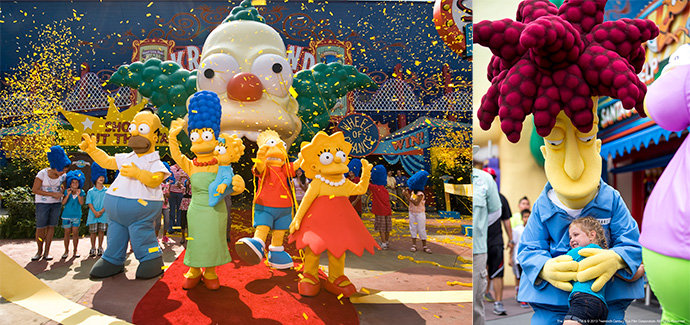
Among the highlights of the area of Universal Orlando Resort devoted to the fictional Springfield of “The Simpsons” are Moe’s Tavern, Kang & Kodos’ Twirl ‘n’ Hurl ride, Krusty Burger and walking characters — though some might question whether being lovable is Sideshow Bob’s best attribute.
Photos courtesy of Universal Orlando Resort
